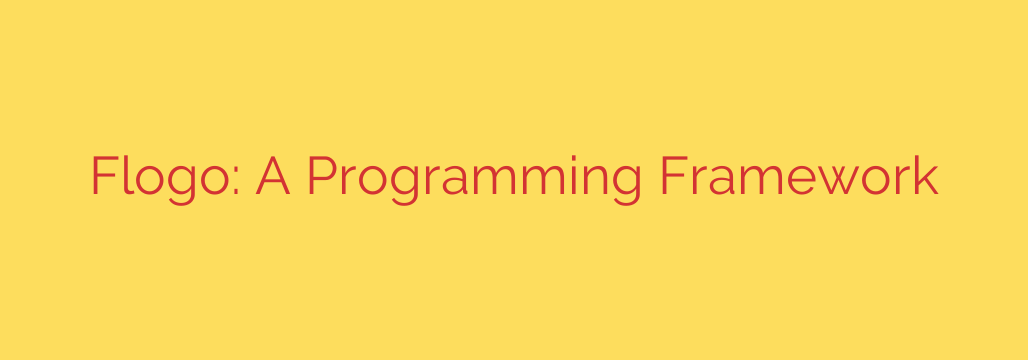
Unlocking Edge and IoT Development with Project Flogo
In the rapidly expanding world of the Internet of Things (IoT), edge computing, and serverless architectures, developers face a critical challenge: building powerful, event-driven applications that can run efficiently on resource-constrained devices. Traditional frameworks are often too heavy and complex for these environments. This is where Project Flogo comes in, offering a modern, lightweight solution designed for performance and simplicity.
Flogo is an open-source, event-driven framework you can use to build applications for edge devices, IoT gateways, and serverless platforms. Written in the Go programming language, it is engineered from the ground up to be incredibly lightweight, enabling developers to create and deploy sophisticated logic in environments where every kilobyte of memory and every CPU cycle counts.
The Core Features That Set Flogo Apart
What makes Flogo a compelling choice for modern development? Its design philosophy centers on efficiency, flexibility, and ease of use.
Ultralightweight and Efficient: This is Flogo’s standout feature. Flogo applications compile into tiny, self-contained static binaries with an incredibly small memory footprint. This makes it perfect for running on devices like Raspberry Pi, industrial sensors, or within minimalist container environments where resources are scarce.
Visual-First Development: Flogo offers a powerful, browser-based visual designer that allows you to create application logic (called “flows”) with a zero-code or low-code approach. You can drag and drop activities, configure triggers, and map data without writing extensive code, significantly accelerating the development process.
Powered by Go (Golang): By leveraging the Go programming language, Flogo inherits its key benefits: exceptional performance, built-in concurrency, and cross-platform compilation. This ensures that Flogo apps are not only small but also blazingly fast and highly scalable.
Highly Extensible and Flexible: The framework is built on a pluggable architecture. You can easily extend its functionality with custom activities (units of work) and triggers (event listeners). A rich ecosystem of pre-built connectors allows for seamless integration with databases, messaging queues like Kafka and MQTT, and various APIs.
Why Choose Flogo? Key Benefits for Developers and Businesses
Adopting Flogo provides tangible advantages for a wide range of projects, from simple IoT data pipelines to complex serverless microservices.
Optimized for the Edge: With its minimal resource consumption, Flogo is a natural fit for edge computing. It allows you to move data processing and real-time decision-making closer to the source, reducing latency and reliance on a central cloud.
Accelerated Time-to-Market: The visual web interface empowers developers and even less technical team members to build and iterate on application logic quickly. This democratizes development and helps you get your product to market faster.
Deploy Virtually Anywhere: A Flogo application is a single, dependency-free executable. This means you have ultimate flexibility in deployment. You can run it on bare metal, inside a Docker container, as an AWS Lambda or Google Cloud Function, or directly on an edge device.
Superior Performance and Reliability: Go’s compiled nature means there’s no need for a heavy runtime interpreter like in Node.js or Python. This results in faster startup times and more predictable performance, which is critical for time-sensitive applications.
Common Use Cases for Project Flogo
Flogo’s versatility makes it suitable for a variety of applications, including:
- IoT Data Integration and Processing: Ingest data from sensors via MQTT or CoAP, perform filtering and transformations on an edge gateway, and forward the relevant information to the cloud.
- Lightweight Microservices and APIs: Quickly build and deploy performant REST APIs that can handle high-concurrency workloads.
- Serverless Functions: Create highly efficient functions for platforms like AWS Lambda that execute quickly and keep costs low.
- Real-Time Event Processing: Build responsive systems that react instantly to events from message brokers, databases, or custom triggers.
Actionable Advice: How to Get Started with Flogo
Getting your first Flogo application running is a straightforward process, thanks to its excellent tooling.
- Install Flogo CLI: The command-line interface is the primary tool for managing your Flogo projects. You can typically install it using a simple
go getcommand. - Launch the Web UI: Use the CLI to create a new project and start the visual designer in your web browser.
- Design Your Flow: In the Web UI, create a new flow. Start by adding a trigger (e.g., “Receive HTTP Message”). Then, drag and drop activities from the palette to define your logic, such as logging a message, querying a database, or calling another API. Connect the activities to define the sequence of execution.
- Build and Deploy: Once your flow is complete, use the Flogo CLI to build the application. This will produce a single, executable binary that you can copy and run anywhere you need it.
Flogo is more than just another framework; it’s a strategic tool for building the next generation of efficient, decentralized applications. By combining the power of Go with an intuitive visual design experience, it provides a powerful solution for the unique challenges of IoT, edge, and serverless computing.
Source: https://www.linuxlinks.com/flogo-programming-language/








